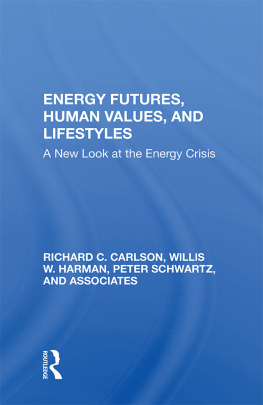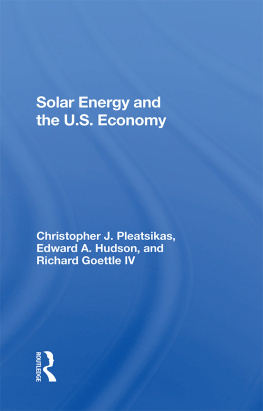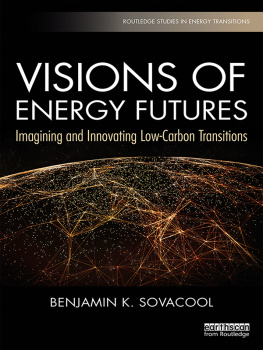ENERGY FUTURES, HUMAN VALUES, AND LIFESTYLES
Also of Interest
The Forever Fuel: The Story of Hydrogen, Peter Hoffmann
Energy from Biological Processes: Technical and Policy Options, Office of Technology Assessment
Renewable Natural Resources: A Management Handbook for the 1980s, edited by Dennis L. Little, Robert E. Dils, and John Gray
Energy Transitions: Long-Term Perspectives , edited by Lewis J. Perelman, August W. Giebelhaus, and Michael D. Yokell
The Economics of Environmental and Natural Resources Policy, edited by J. A. Butlin
Climate Change and Society: Consequences of Increasing Atmospheric Carbon Dioxide, William W. Kellogg and Robert Schware
The Future of U.S. Politics in an Age of Economic Limits, Bruce M. Shefrin
World Economic Development: 1979 and Beyond, Herman Kahn
The Economic Value of the Quality of Life, Thomas M. Power
Eating Oil: Energy Use in Food Production, Maurice B. Green
Living with Energy Shortfall: A Future for American Towns and Cities, Jon Van Til
Available in hardcover and paperback
About the Book and Authors
Energy Futures, Human Values, and Lifestyles: A New Look at the Energy Crisis
Richard C. Carlson, Willis W. Harman, Peter Schwartz, and Associates
The contours of our energy future are most clearly presented as hard and painful choices. We can, for instance, maintainperhaps even greatly improveour current living standards, but at tremendous cost to our environment and to our physical and human resources. Alternatively, we can opt for a more humane society and in many ways a richer life with the long-term energy resources to maintain it, but accept the accompanying reduction of the economic status quo. This book, by a group of scholars from SRI international, one of the nation's leading research institutions, demonstrates the vast potential of some surprisingly human answers to this dilemma. Looking beyond the vast technical difficulties of the energy crisis, it seeks the basic reasons for the severity of our energy and environmental problemsand finds them in our individual choices of lifestyle.
The authors depict two detailed energy-use scenarios for the year 2050, using California as a model. One scenario portrays a future that is the result of our present habits, a future in which we will have squandered nearly all of the world's nonrenewable energy resources and neither conserved nor developed renewable resources. The other is a vision of calm, somewhat slower economic progress, the result of energy put to work to create a more acceptable and fulfilling life for all-psychologically, socially, and physically. The first reflects a rapid push ahead in a barely controllable race for technological development; in the second, energy serves long-range human goals and values and there is room for a broad range of lifestyles. In one, people are jammed into continually dirtier and more crowded cities; the other has accommodated population growth with room for all.
Is the second scenario just another utopian dream? Not at all, say the authors, presenting the crucial issues logically and convincingly. The authors are sober and realistic in their assessments of what is possible and what is not, what must be sacrificed and what cannot be, what must be changed and what can remain the same.
As a pacesetter for the rest of the country in more than one sense, California is an apt basis for the authors' prognostications. It is the ideal paradigm for the nation's future: What seems possible for California should be possible for the entire country.
Richard C. Carlson is a senior economist in SRI International's International Development Center and was chief coordinator of the project on which this book is based. Willis W. Harman is a senior social scientist in the SRI International Development Center, a professor of engineering and economic systems at Stanford University, and a regent of the University of California; he is author of An Incomplete Guide to the Future. Peter Schwartz was director of the SRI Strategic Environment Center and chief coordinator of futures research at SRI. Working with them on the book were Sidney J. Everett (SRI Center for Resource and Environmental Systems Studies); Klaus W. Krause, Thomas F. Mandel, Lynn Rosener, and Thomas C. Thomas (SRI Strategic Environment Center); Paul C. Meagher (SRI Energy Center); and Stephen Levy (Center for the Continuing Study of the California Economy).
Energy Futures, Human Values, and Lifestyles
A New Look at the Energy Crisis
Richard C. Carlson, Willis W. Harman, Peter Schwartz, and Associates
First published 1882 by Westview Press, Inc.
Published 2018 by Routledge
52 Vanderbilt Avenue, New York, NY 10017
2 Park Square, Milton Park, Abingdon, Oxon OX14 4RN
Routledge is an imprint of the Taylor & Francis Group, an informa business
Copyright 1982 Taylor & Francis
All rights reserved. No part of this book may be reprinted or reproduced or utilised in any form or by any electronic, mechanical, or other means, now known or hereafter invented, including photocopying and recording, or in any information storage or retrieval system, without permission in writing from the publishers.
Notice:
Product or corporate names may be trademarks or registered trademarks, and are used only for identification and explanation without intent to infringe.
Library of Congress Cataloging in Publication Data
Carlson, Richard C.
Energy futures, human values, and lifestyles.
"Published in cooperation with SRI International" P. iv.
Includes index.
1. Energy policy. 2. Energy policyUnited States. 3. Energy policyCalifornia. I. Harman, Willis W.
II. Schwartz, Peter. III. Title.
HD9502.A2C38 333.79'0973 81-21866
AACR2
ISBN 13: 978-0-367-01882-5 (hbk)
1
Introduction
The year is 2050. California's population has risen to 35 million; in 1975 it was only 60 percent of that. But population and industry are more evenly dispersed, so crowding in urban areas has actually decreased slightly. Californians are wealthier than they were in 1975; average personal income has roughly doubled (in constant dollars) and economic disparities have been reduced. Along with this wealth has come a lessening of the value of material accumulation as an end in itself; more emphasis is placed on quality of the environment, on relationships, and on self-development. There is a far greater diversity of lifestyles than existed in 1975, and people have adopted a wide range of alternative living patterns for meeting human needs and satisfying human desires. Family and neighborhood relationships are cherished, and in some respects there are more home- and community-based activities than there were three-quarters of a century earlier. Overall, there has been a gradual decentralization of institutions, governance, and economic activities. Technology is far more sophisticated, yet less domineering, and more decentralized, person-augmenting, resource-conserving, and environmentally benign. There has been a significant shift toward distributed energy systems employing renewable sources. A strong "voluntary" or "third" sector flourishes and it fosters the diversity of values and lifestyles. Work patterns are also diverse; many persons choose to work much less than the old standard 40 hours a week; and the boundaries between work, learning, and leisure are significantly blurred. Environmental quality is, on the whole, better than in the late 1970s. There are problems, but they appear to be manageable. And in this California of 2050, improved in many ways over the California of the mid-1970s, the per capita energy requirement is only about 60 percent of what it was then!









